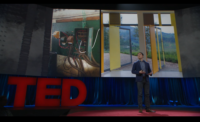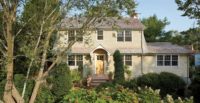Vancouver, British Columbia
Having designed theater sets for Broadway shows and the Oscars, architect David Rockwell knew a lot about temporary structures. But he had never designed a temporary theater. Until Chris Anderson, who runs the organization behind the Technology, Entertainment and Design (TED) talks, asked Rockwell to create a pop-up home for its annual conference—one that could be erected inside a ballroom at the Vancouver Convention Center, disassembled, stored, and then reassembled a year later in the same place or shipped somewhere else.
Though the project was a different kind of challenge for the architects, “it intersected with things we have been investigating for the past 30 years—craft, spectacle, community, and the ephemeral nature of theater,” says Rockwell.
Making the theater feel intimate, even as it holds 1,200 people, was imperative. In TED's previous home in Long Beach, California, some seats were as far as 125 feet from the stage; the custom-built theater in Vancouver would reduce this to 80 feet. And instead of a uniform arc of seats with one or two aisles, Rockwell created a patchwork of sections with 10 different kinds of seating—including ringside benches, lounge-type arrangements with sofas, and rows that have a combination of chairs and benches. “People like having a choice,” says Rockwell, and the different options help them gather in informal groups within the larger community.
As they worked, Rockwell and his project manager, Michael Fischer, kept a few precedents in mind: medieval pageant plays with their mobile stages, Shakespeare's timber-frame Globe Theater in London, and Hans Scharoun's Berlin Philharmonic. Though neither temporary nor made of wood, the Berlin Philharmonic (completed in 1963) breaks a large expanse of 2,440 seats into various sections, which inspired Rockwell to do the same. “We liked the way Scharoun created a topography of seating,” says Rockwell.
To speed construction, Rockwell worked with Nussli, a Swiss company that supplies temporary structures for trade fairs and now has offices in the U.S. Together they designed a system of “boxes” that could be attached side by side or stacked on top of each other—some as seating sections, some as stairs, and others as “hats” crowning the theater's perimeter. Like a building, the structure needed to handle live and dead loads, but each individual box also had to accommodate the dynamic forces imposed when picked up and moved. The dimensions of the boxes were dictated by the ballroom doors through which they would pass: 10 feet by 8 feet. Their length was limited by the size of the flatbed trucks that would transport them: 30 feet (but most pieces were just 12 feet).
A Vancouver company, CutMyTimber, used computer-numerical-controlled (CNC) milling that reduced waste to just 2 percent. Nussli assembled the pieces—mostly 4-by-6-inch Douglas fir glulam and Douglas fir plywood—into about 160 boxes, starting with the ones that would be needed last (and could be stored in the back of the warehouse) and finishing with those needed first. After three months of manufacturing off-site, trucks delivered the boxes in 60 loads, plus three of equipment, tools, and floor protection. Over the course of just five days last March, two 12-hour shifts of 30 workers built the stage, connected the boxes using nuts and washers—on threaded steel rods embedded in the wood—and added infill elements such as beams, slatted guardrails, cross-laminated-timber railings, and plywood flooring, all made of the same Douglas fir as the boxes.
After the conference, the crews took two and a half days to disassemble the theater. Nussli has guaranteed the project for 10 iterations, but Fischer says, “We feel it could probably last more than that.” Though no one has decided what will happen to the wood after such a time, Fischer says CutMyTimber has a database of the 8,000 pieces it cut and could use it as an inventory for recycling and remilling them.
According to Rockwell, the new theater helped “give a boost” to a 30-year-old event while highlighting the ephemeral nature of such gatherings. Anderson, the client, says, “Our community absolutely loved the theater. We'll make just some minor tweaks—a slightly smaller stage, a few more seats, and some lighting and audio adjustments.” The biggest surprise, he says, was “the powerful scent of the wood itself. It blew us away.”
PeopleFormal name of building: TED Theater Location: Vancouver, B.C. Client: TED Owner: TED
Architect:
Personnel in architect's firm who should receive special credit: Interior designer: Rockwell Group
Engineers:
Consultant(s): Stage Lighting Design: Intensity Advisors Stage Lighting Show Install: Christie Lites
Acoustical:
Other: Rigging: Riggit Facility Management: Vancouver Convention Center General contractor: Nussli
Photographer(s): Gross square footage: 20,000 SF / 1,200 seats Project cost: Withheld Completion date: March 2014 |
Products
Structural system Types of Wood:
Manufacturer of any structural components unique to this project:
Interior finishes
Furnishings
Other furniture:
Lighting
Other unique products that contribute to sustainability:
Add any additional building components or special equipment that made a significant contribution to this project: |











Post a comment to this article
Report Abusive Comment